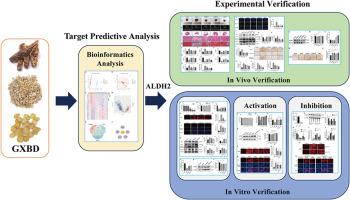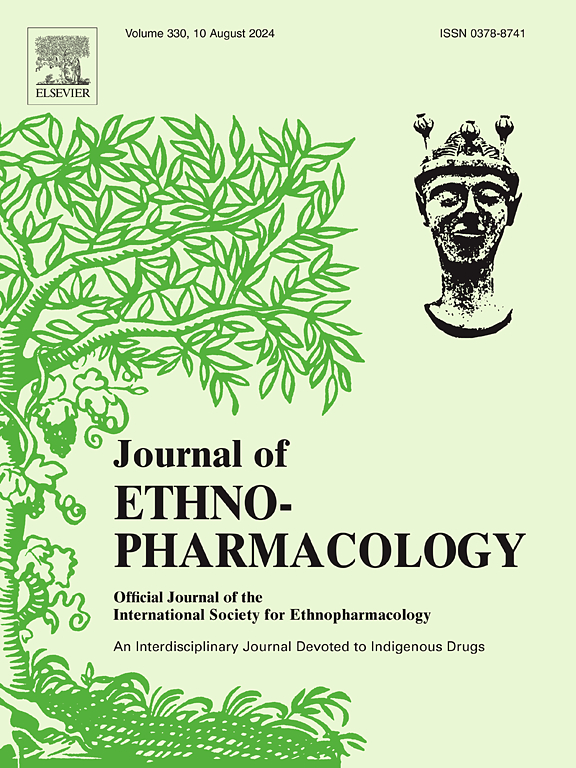Gualou Xiebai Banxia Decoction suppresses cardiomyocyte apoptosis in mice after myocardial infarction through activation of acetaldehyde dehydrogenase 2
IF 5.4
2区 医学
Q1 CHEMISTRY, MEDICINAL
引用次数: 0
Abstract
Ethnopharmacological relevance
Cardiac apoptosis has been reported to be involved in the development of Heart failure (HF) after Myocardial infarction (MI). As a traditional Chinese medicine with cardioprotective properties, Gualou Xiebai Banxia Decoction (GXBD) is therapeutically effective in treating MI. However, whether GXBD regulates cardiac apoptosis in HF after MI remains unknown, and the underlying mechanisms still unclear.
Aim of the study
This study aimed to explore the effects and potential mechanisms of GXBD on cardiac apoptosis after MI.
Materials and methods
The MI model was constructed by ligating the left anterior descending coronary artery (LAD) in mice. The cardioprotective effects of GXBD were determined by echocardiography, masson staining, and haematoxylin and eosin (HE) staining. Bioinformatics analysis and network Pharmacology were used to explore the underlying molecular mechanisms of GXBD in MI. The effects of GXBD on cardiomyocyte apoptosis as well as the ALDH2 were examined by TUNEL staining, Immunohistochemistry (IHC), and Western blot (WB). Additionally, the effects of GXBD on oxidative stress, apoptosis and the ALDH2 in H9c2 cells were investigated using reactive oxygen species (ROS) detection, Hoechst33342/PI stainingand and WB. Moreover, the effects of suppressing and overexpressing ALDH2 in H9c2 cells were further examined.
Results
Target prediction analysis showed that ALDH2 was a key target of GXBD which could ameliorate myocardial infarction. GXBD dose-dependently reduced cardiomyocyte apoptosis and ventricular dysfunction. In vivo experiments, GXBD activated ALDH2 enzymatic activity and inhibited the expression levels of Bax, Bcl-2, Cleaved Caspase 3, and Caspase 9. In vitro experiments, GXBD inhibited apoptosis in H9c2 cells. The inhibitory effects of GXBD on these were at least partially attributed to ALDH2 activation while silencing of ALDH2 significantly reversed these inhibitory effects of GXBD.
Conclusion
GXBD exerts inhibitory effects on cardiomyocyte apoptosis in mice after MI and suppresses H9c2 cells oxidative stress and apoptosis through activation of the enzyme activity of ALDH2.

瓜蒌解百半夏汤通过激活乙醛脱氢酶2抑制小鼠心肌梗死后的心脏凋亡
民族药理学意义:据报道,心肌梗塞(MI)后心力衰竭(HF)的发生与心脏凋亡有关。作为一种具有心脏保护作用的传统中药,瓜蒌解百半夏煎剂(GXBD)对治疗心肌梗死具有疗效。然而,GXBD是否能调节心肌梗死后高房颤患者的心脏凋亡仍是未知数,其潜在机制也尚不清楚:本研究旨在探讨GXBD对心肌梗死后心脏凋亡的影响和潜在机制:通过结扎小鼠左冠前降支动脉(LAD)建立心肌梗死模型。通过超声心动图、Masson 染色和苏木精及伊红(HE)染色确定 GXBD 的心脏保护作用。生物信息学分析和网络药理学被用来探索GXBD对心肌梗死的潜在分子机制。通过TUNEL染色、免疫组织化学(IHC)和Western blot(WB)检测了GXBD对细胞凋亡和ALDH2的影响。此外,还使用活性氧(ROS)检测、Hoechst33342/PI 染色和 WB 检测了 GXBD 对心肌细胞(H9c2)氧化应激、细胞凋亡和 ALDH2 的影响。此外,还进一步研究了抑制和过表达 ALDH2 对 H9c2 细胞的影响:结果:靶点预测分析表明,ALDH2是GXBD的一个关键靶点,可改善心肌梗死。GXBD 可剂量依赖性地减少心肌细胞凋亡和心室功能障碍。在体内实验中,GXBD 激活了 ALDH2 酶的活性,抑制了 Bax、Bcl-2、Cleaved Caspase 3 和 Caspase 9 的表达水平。在体外实验中,GXBD 可抑制 H9c2 细胞的凋亡。ALDH2 的激活增强了 GXBD 的抑制作用,而 ALDH2 的沉默则显著逆转了 GXBD 的抑制作用:结论:GXBD 对心肌梗死后小鼠的氧化应激和心肌细胞凋亡具有抑制作用,通过激活 ALDH2 的酶活性抑制 H9c2 氧化应激和细胞凋亡。
本文章由计算机程序翻译,如有差异,请以英文原文为准。
求助全文
约1分钟内获得全文
求助全文
来源期刊

Journal of ethnopharmacology
医学-全科医学与补充医学
CiteScore
10.30
自引率
5.60%
发文量
967
审稿时长
77 days
期刊介绍:
The Journal of Ethnopharmacology is dedicated to the exchange of information and understandings about people''s use of plants, fungi, animals, microorganisms and minerals and their biological and pharmacological effects based on the principles established through international conventions. Early people confronted with illness and disease, discovered a wealth of useful therapeutic agents in the plant and animal kingdoms. The empirical knowledge of these medicinal substances and their toxic potential was passed on by oral tradition and sometimes recorded in herbals and other texts on materia medica. Many valuable drugs of today (e.g., atropine, ephedrine, tubocurarine, digoxin, reserpine) came into use through the study of indigenous remedies. Chemists continue to use plant-derived drugs (e.g., morphine, taxol, physostigmine, quinidine, emetine) as prototypes in their attempts to develop more effective and less toxic medicinals.
 求助内容:
求助内容: 应助结果提醒方式:
应助结果提醒方式:


